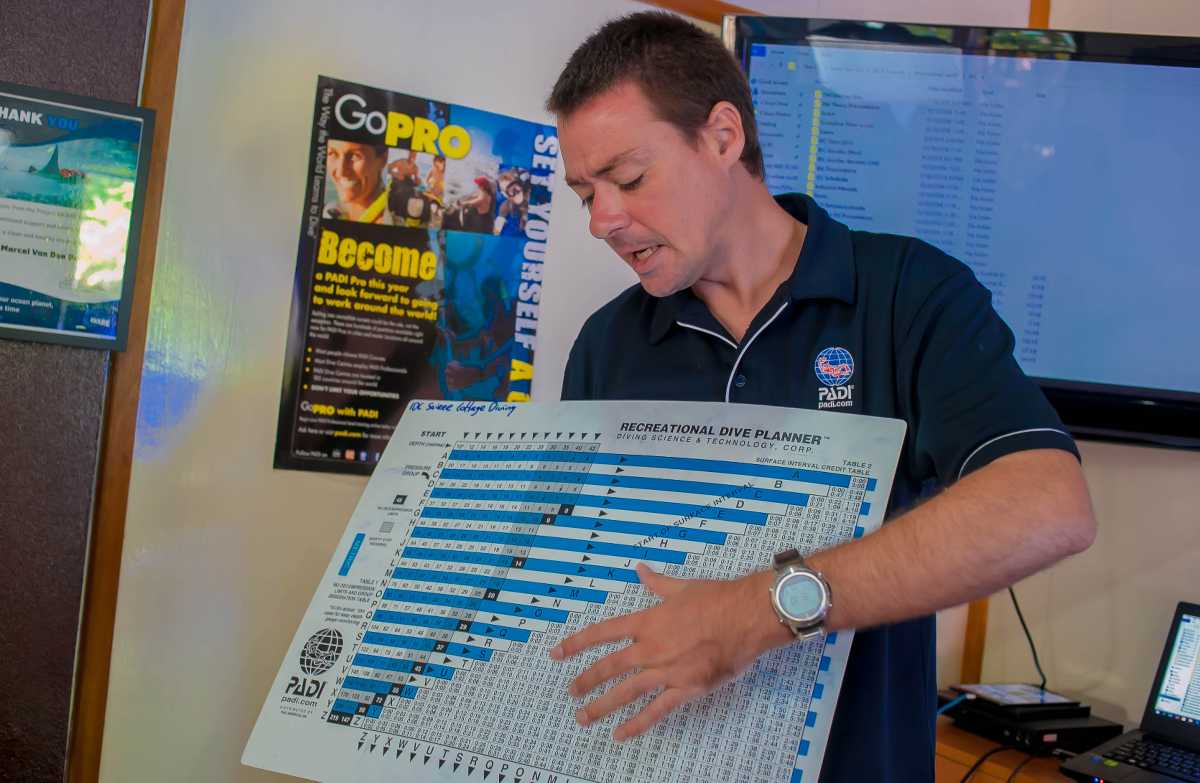A lot of people in my IDC courses have questions about the PADI Recreational Dive Planner the RDP. During the PADI Dive Instructor Development course my IDC candidates mostly have questions about how the RDP has been created and why are there certain rules in using the PADI RDP to plan dives safely. Here is PADI explanation and hopefully it will help you in your IDC course.
Prior to the mid 1980s, almost every diver used the same table: the US Navy tables (available in various layouts). Since then however, the use of the venerable US Navy Tables by recreational divers has faded to nearly zero, replaced by dive computers and the RDP (Recreational Dive Planner).
There’s nothing wrong with the US Navy tables, but they weren’t designed for recreational divers. In the 1950s, before the rise of the computer age, developing tables was a laborious, time consuming process. As a result, the early sport diving industry adopted the only tables available – the Navy’s. But, in the 1980s everything changed, thanks to modern computing.
 In 1983, Dr. Raymond Rogers began analyzing the US Navy tables and compared them to the needs of recreational diving and the latest findings by decompression physiologists. He found that the US Navy tables had several disadvantages for recreational divers. More recent data showed that the US Navy no decompression limits where perhaps a bit too generous for civilian fun divers. Dr. Rogers concluded that tables for recreational divers would have somewhat shorter no decompression limits for single dives, and the underlying decompression model would have more conservative maximum nitrogen limits.
In 1983, Dr. Raymond Rogers began analyzing the US Navy tables and compared them to the needs of recreational diving and the latest findings by decompression physiologists. He found that the US Navy tables had several disadvantages for recreational divers. More recent data showed that the US Navy no decompression limits where perhaps a bit too generous for civilian fun divers. Dr. Rogers concluded that tables for recreational divers would have somewhat shorter no decompression limits for single dives, and the underlying decompression model would have more conservative maximum nitrogen limits.
Second, he observed that US Navy tables must account for the fact that repetitive dives may be preceded by a decompression dive. This meant that repetitive dives had to be heavily restricted to account for the large residual nitrogen loads from a previous decompression dive. Dr. Rogers concluded that tables for recreational divers could allow longer repetitive dives, because they wouldn’t need to accommodate decompression dives.
Based on his findings, Dr. Rogers formulated a decompression model specifically for recreational, no decompression diving. From that model he produced the Recreational Dive Planner – the first tables developed specifically for recreational divers. Thanks to the model’s more conservative nitrogen limits, yet more appropriate control of repetitive dives, the RDP has shorter no stop limits for single dives but often allows longer repetitive dives compared with the US Navy tables.
 To validate the RDP concepts, volunteers made hundreds of manned test dives during 1987 under the direction of Dr. Michael R. Powell at the institute of Applied Physiology and Medicine (IAMP) in Seattle, Washington. After successful testing, which included both recompression chamber and in water trials, the RDP was introduced by Diving Science & Technology (DSAT) in 1988 for distribution by PADI. In 1989, DSAT and IAMP extended the test database with a trial of multiple repetitive no decompression diving (four dives daily for six days) and this successful series of tests was the first formal investigation of multiple day, repetitive diving ever undertaken.
To validate the RDP concepts, volunteers made hundreds of manned test dives during 1987 under the direction of Dr. Michael R. Powell at the institute of Applied Physiology and Medicine (IAMP) in Seattle, Washington. After successful testing, which included both recompression chamber and in water trials, the RDP was introduced by Diving Science & Technology (DSAT) in 1988 for distribution by PADI. In 1989, DSAT and IAMP extended the test database with a trial of multiple repetitive no decompression diving (four dives daily for six days) and this successful series of tests was the first formal investigation of multiple day, repetitive diving ever undertaken.
At its introduction, there were two types of the RDP: metric and imperial. The RDP Table, which differs little from the RDP Table available today, presented Dr. Rogers’ concepts in the familiar tabular format. Dr. Rogers also developed The Wheel, which had a circular, slide-rule type format to minimize unnecessary rounding and to make it feasible to plan multilevel dives.
In 1995, Dr. Rogers also developed metric and imperial versions of the RDP for use with EANx (Enriched Air Nitrox) 32 and 36. These Tables were introduced in 1996 with the PADI Enriched Air Diver Course.
2005 marked another RDP first with the introduction of the eRDP – the world’s first electronic dive table. Resembling a calculator, the eRDP simplified dive planning by carrying out table look up functions electronically. In 2008, both the eRDP and the Wheel were phased out with the introduction of the eRDPml. The eRDPml offers the same calculator convenience as the eRDP, but wraps in The Wheel’s reduction of unnecessary rounding plus multilevel dive capability. Today, there are millions of RDPs in use worldwide. In addition, several dive computers were developed based on the Recreational Dive Planner Test Data. Because it is tailored to repetitive no decompression diving, the RDP is the Single most popular dive table for recreational diving.
Like & Share
